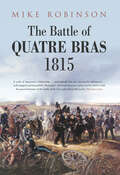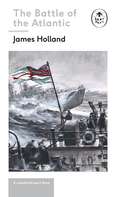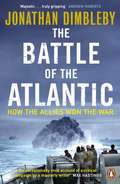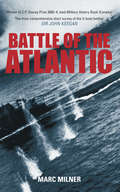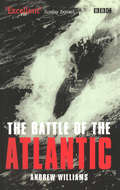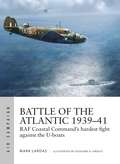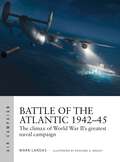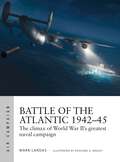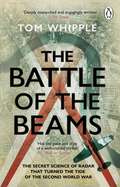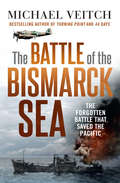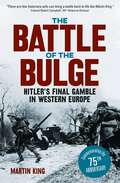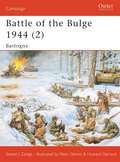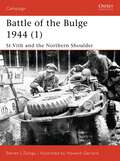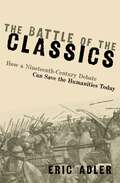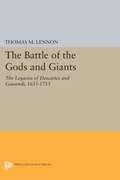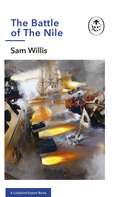- Table View
- List View
The Battle of Quatre Bras 1815 (History Press Ser.)
by Mike RobinsonQuatre Bras was the battle that turned a campaign – a tale of triumph and disaster. The Battle of Quatre Bras 1815 is not only a significant addition to the written history of the Napoleonic Wars, it is also the first English language account to focus solely on this crucial battle of the Waterloo campaign. Mike Robinson’s compelling account is based on extensive original research and includes many unpublished personal accounts from all the participating nations. The author combines this testimony with an unparalleled study of the topography of the battlefield and deep knowledge of Napoleonic warfare to tell the story of a battle where commanders made errors of omission and commission and where cowardice rubbed shoulders with heroism. Above all, it is the story of the intense human experience of those who participated in the events of those two fateful days in June 1815.
Battle of the Atlantic: (WW2 #3) (The Ladybird Expert Series)
by Keith Burns James HollandPart of the ALL-NEW Ladybird Expert series.Find out about WWII's longest battle. This is an accessible, insightful and authoritative account of the naval campaign that kept supply lines open and enabled Britain to continue to fight. Historian, author and broadcaster James Holland draws on the latest research and interviews with participants to bring colour, detail and a fresh perspective to the story of how the siege of Europe was broken.Inside, you'll discover exactly what happened in the Battle of the Atlantic. Ships, submarines and aircraft fought a bitter war that saw the deaths of over 100,000 servicemen and civilians. What's inside?- The tragic demise of SS Athenia- The power of U-boats- Advantages of Britain's naval experience- German naval Enigma codes- The rapid development of advancing weaponry- And much more . . . Written by the leading lights and most outstanding communicators in their fields, the Ladybird Expert books provide clear, accessible and authoritative introductions to subjects drawn from science, history and culture.For an adult readership, the Ladybird Expert series is produced in the same iconic small hardback format pioneered by the original Ladybirds. Each beautifully illustrated book features the first new illustrations produced in the original Ladybird style for nearly forty years.
The Battle of the Atlantic: How the Allies Won the War
by Jonathan DimblebyA gripping tale that transforms our understanding of the Second World WarThe Battle of the Atlantic was - though often overlooked - crucial to victory in the Second World War. If the German U-boats had prevailed, the maritime artery across the Atlantic would have been severed. Mass hunger would have consumed Britain, and the Allied armies would have been prevented from joining in the invasion of Europe. There would have been no D-Day.Through fascinating contemporary diaries and letters, from the leaders and from the sailors on all sides, Jonathan Dimbleby creates a thrilling narrative that uniquely places the campaign in the context of the entire Second World War. Challenging conventional wisdom on the use of intelligence and on Churchill's bombing campaign, The Battle of the Atlantic tells the epic story of the decisions that led to victory, and the horror and humanity of life on those perilous seas.
Battle of the Atlantic (Revealing History Ser.)
by Marc MilnerWorld War II was only a few hours old when the Battle of the Atlantic, the longest campaign of the Second World War and the most complex submarine war in history, began with the sinking of the unarmed passenger liner Athenia by the German submarine U30. Based on the mastery of the latest research and written from a mid-Atlantic - rather than the traditional Anglo-centric - perspective, Marc Milner focuses on the confrontation between opposing forces and the attacks on Allied shipping that lay at the heart of the six-year struggle. Against the backdrop of the battle for the Atlantic lifeline he charts the fascinating development of U-boats and the techniques used by the Allies to suppress and destroy these stealth weapons.
The Battle Of The Atlantic: The Allies' Submarine Fight Against Hitler's Gray Wolves Of The Sea (Art Of Mentoring Ser.)
by Andrew WilliamsFrom 1939 until 1942, Hitler's U-boats - his 'grey wolves' - threatened to accomplish what his air force had hitherto been unable to achieve: to starve Britain into submission. The struggle for control of the Atlantic was to become the longest, and one of the most bitterly fought campaigns of World War II. For Winston Churchill it was 'the only thing that ever really frightened me during the war'. During the course of five bloody and uncertain years, Britain and her Allies lost more than fifty thousand seamen and fifteen million tons of shipping protecting this lifeline. In 'The Battle of the Atlantic', Andrew Williams vividly describes this intense and strategically vital campaign in the fight for Allied victory. '...an excellent book.' Sunday Express
Battle of the Atlantic 1939–41: RAF Coastal Command's hardest fight against the U-boats (Air Campaign #15)
by Mark LardasAt the start of World War II, few thought the U-boat would be as devastating as it proved to be. But convoys and sonar-equipped escorts proved inadequate to defend the Allies' merchantmen, and the RAF's only offensive weapon was the anti-submarine warfare (ASW) aircraft. For RAF Coastal Command, the first two years of the war were the hardest. Although starved of resources, operating with outdated aircraft and often useless weaponry, they were still the only force that could take the fight to the U-boats. But in these two years, the RAF learned what it needed to win the Battle of the Atlantic. Gradually developing new tactics and technology, such as airborne radar, signals intelligence, and effective weaponry, the Allies ended 1941 in a position to defeat Dönitz's growing fleet of U-boats. This book, the first of two volumes, explains the fascinating history of how the RAF kept the convoys alive against the odds, and developed the force that would prevail in the climactic battles of 1942 and 1943.
Battle of the Atlantic 1939–41: RAF Coastal Command's hardest fight against the U-boats (Air Campaign #15)
by Mark LardasAt the start of World War II, few thought the U-boat would be as devastating as it proved to be. But convoys and sonar-equipped escorts proved inadequate to defend the Allies' merchantmen, and the RAF's only offensive weapon was the anti-submarine warfare (ASW) aircraft. For RAF Coastal Command, the first two years of the war were the hardest. Although starved of resources, operating with outdated aircraft and often useless weaponry, they were still the only force that could take the fight to the U-boats. But in these two years, the RAF learned what it needed to win the Battle of the Atlantic. Gradually developing new tactics and technology, such as airborne radar, signals intelligence, and effective weaponry, the Allies ended 1941 in a position to defeat Dönitz's growing fleet of U-boats. This book, the first of two volumes, explains the fascinating history of how the RAF kept the convoys alive against the odds, and developed the force that would prevail in the climactic battles of 1942 and 1943.
Battle of the Atlantic 1942–45: The climax of World War II’s greatest naval campaign (Air Campaign)
by Mark LardasAs 1942 opened, both Nazi Germany and the Allies were ready for the climactic battles of the Atlantic to begin. Germany had 91 operational U-boats, and over 150 in training or trials. Production for 1942–44 was planned to exceed 200 boats annually. Karl Dönitz, running the Kriegsmarine's U-boat arm, would finally have the numbers needed to run the tonnage war he wanted against the Allies.Meanwhile, the British had, at last, assembled the solution to the U-boat peril. Its weapons and detection systems had improved to the stage that maritime patrol aircraft could launch deadly attacks on U-boats day and night. Airborne radar, Leigh lights, Magnetic Anomaly Detection (MAD) and the Fido homing torpedo all turned the anti-submarine warfare (ASW) aircraft into a submarine-killer, while shore and ship-based technologies such as high-frequency direction finding and signals intelligence could now help aircraft find enemy U-boats. Following its entry into the war in 1941, the United States had also thrown its industrial muscle behind the campaign, supplying VLR Liberator bombers to the RAF and escort carriers to the Royal Navy. The US Navy also operated anti-submarine patrol blimps and VLR aircraft in the southern and western Atlantic, and sent its own escort carriers to guard convoys.This book, the second of two volumes, explores the climactic events of the Battle of the Atlantic, and reveals how air power – both maritime patrol aircraft and carrier aircraft – ultimately proved to be the Allies' most important weapon in one of the most bitterly fought naval campaigns of World War II.
Battle of the Atlantic 1942–45: The climax of World War II’s greatest naval campaign (Air Campaign #21)
by Mark LardasAs 1942 opened, both Nazi Germany and the Allies were ready for the climactic battles of the Atlantic to begin. Germany had 91 operational U-boats, and over 150 in training or trials. Production for 1942–44 was planned to exceed 200 boats annually. Karl Dönitz, running the Kriegsmarine's U-boat arm, would finally have the numbers needed to run the tonnage war he wanted against the Allies.Meanwhile, the British had, at last, assembled the solution to the U-boat peril. Its weapons and detection systems had improved to the stage that maritime patrol aircraft could launch deadly attacks on U-boats day and night. Airborne radar, Leigh lights, Magnetic Anomaly Detection (MAD) and the Fido homing torpedo all turned the anti-submarine warfare (ASW) aircraft into a submarine-killer, while shore and ship-based technologies such as high-frequency direction finding and signals intelligence could now help aircraft find enemy U-boats. Following its entry into the war in 1941, the United States had also thrown its industrial muscle behind the campaign, supplying VLR Liberator bombers to the RAF and escort carriers to the Royal Navy. The US Navy also operated anti-submarine patrol blimps and VLR aircraft in the southern and western Atlantic, and sent its own escort carriers to guard convoys.This book, the second of two volumes, explores the climactic events of the Battle of the Atlantic, and reveals how air power – both maritime patrol aircraft and carrier aircraft – ultimately proved to be the Allies' most important weapon in one of the most bitterly fought naval campaigns of World War II.
The Battle of the Beams: The secret science of radar that turned the tide of the Second World War
by Tom Whipple'Deeply researched and engagingly written' The Times'Has the pace and style of a well-crafted thriller' Mail on Sunday'Chock full of memorable characters and written with all the drama and pace of a Robert Harris thriller' Rowland White, author of MosquitoSummer 1939. War is coming. The British believe that, through ingenuity and scientific prowess, they alone have a war-winning weapon: radar. They are wrong. The Germans have it too.They believe that their unique maritime history means their pilots have no need of navigational aids. They are wrong. Most of the bombs the RAF will drop in the first years of the war land miles from their target.They also believe that the Germans, without the same naval tradition, will never be able to find targets at night. They are, again, wrong.In 1939 the Germans don't just have radar to spot planes entering their airspace, they have radio beams to guide their own planes into enemy airspace.This war will be fought on land and sea and in the air, but it will also be fought on the airwaves. It will be fought between scientists on both sides at the forefront of knowledge, and the agents and commandos they relied on to bolster that knowledge. Thanks to one young engineer, Reginald Jones, the British develop radar technology that went on to help the Allies win the war.Relying on first-hand accounts from Reginald Jones as well as papers recently released by the Admiralty, The Battle of the Beams fills a huge missing piece in the canon of World War II literature. It is a tale that combines history, science, derring do and dogged determination and will appeal as much to fans of World War II history as to those fascinated by the science behind the beams that changed our lives.The radio war of 1939-45 is one of the great scientific battles in history. This is the story of that war.
The Battle of the Bismarck Sea
by Michael VeitchIn the thick of World War II, during the first week of March 1943, Japan made a final, desperate lunge for control of the South West Pacific. In the ensuing Battle of the Bismarck Sea, a force of land-based Australian and American planes attacked a massive convoy of Japanese warships. The odds were against them. But a devastating victory was won and Japan's hopes of regaining the initiative in New Guinea destroyed. More importantly for Australians, the victory decisively removed any possibility that Australia might be invaded by Japanese forces. It was, for us, one of the most significant times in our history - a week when our future was profoundly in the balance. Bestselling author Michael Veitch tells the riveting story of this crucial moment in history - how the bravery of young men and experienced fighters, renegades and rule-followers, overcame some of the darkest days of World War II.
The Battle of the Bulge: The Allies' Greatest Conflict on the Western Front
by Martin King"Martin King tells the human side of the story of the Battle of the Bulge better than anyone." Commander Jeffrey Barta, US Navy (retired) "I have walked the battlefields with Martin King, who has traversed them countless times with veterans of the Bulge. No one knows this story like Martin, and no one can tell it quite the way he does." Rick Beyer, New York Times bestselling author of The Ghost Army of World War II The vortex of a tornado is a vacuum, and that is where we were, in the centre of a storm of armour and artillery pushing forward into the Ardennes. - John Hillard Dunn, 106th Division, US Army The Battle of the Bulge was the largest land engagement of World War II. The German counter-attack, spearheaded by three Panzer armies, found the Allies unprepared and ill-equipped. As the fighting raged across the frosty forests of the Ardennes, it was left to a few untested US Infantry divisions to hold the Allied lines. Written by one of the world's leading experts on the subject, this account provides an essential introduction to the events of winter 1944-5 and to the many soldiers who risked their lives in defence of freedom. Drawing on personal interviews, extensive research, and an unparalleled knowledge of the region, Martin King explores one of the most important battles of World War II.
Battle of the Bulge 1944: Bastogne (Campaign)
by Peter Dennis Steven J. Zaloga Howard GerrardThe Ardennes offensive in December 1944, known to history as the "Battle of the Bulge†?, was the decisive campaign of the war in North-West Europe. When the attack in the north by 6th Panzer Army failed, Hitler switched the focus of the offensive to General Manteuffel's 5th Panzer Army farther south. Overwhelming the green US 106th Division, German Panzers flooded towards the River Meuse. Barring their way was the crossroads town of Bastogne, reinforced at the last minute by the paratroopers of the 101st Airborne, the 'Screaming Eagles†?. The stage was set for one of the epic struggles of the war – the battle for Bastogne.
Battle of the Bulge 1944: Bastogne (Campaign #145)
by Peter Dennis Steven J. Zaloga Howard GerrardThe Ardennes offensive in December 1944, known to history as the "Battle of the Bulge†?, was the decisive campaign of the war in North-West Europe. When the attack in the north by 6th Panzer Army failed, Hitler switched the focus of the offensive to General Manteuffel's 5th Panzer Army farther south. Overwhelming the green US 106th Division, German Panzers flooded towards the River Meuse. Barring their way was the crossroads town of Bastogne, reinforced at the last minute by the paratroopers of the 101st Airborne, the 'Screaming Eagles†?. The stage was set for one of the epic struggles of the war – the battle for Bastogne.
Battle of the Bulge 1944: St Vith and the Northern Shoulder (Campaign)
by Steven J. Zaloga Howard GerrardThe Battle of the Bulge was the largest and most costly battle fought by the US Army in World War II. The Ardennes fighting was Hitler's last gamble on the Western Front, crippling the Wehrmacht for the remainder of the war. In the first of two volumes on the Ardennes campaign Steven Zaloga details the fighting in the northern sector around St Vith and the Elsenborn Ridge. Sixth Panzer Army, containing the bulk of German Panzer strength, was expected to achieve the breakthrough here. It was the failure around St Vith that forced the Germans to look south towards Bastogne.
The Battle of the Classics: How a Nineteenth-Century Debate Can Save the Humanities Today
by Eric AdlerThese are troubling days for the humanities. In response, a recent proliferation of works defending the humanities has emerged. But, taken together, what are these works really saying, and how persuasive do they prove? The Battle of the Classics demonstrates the crucial downsides of contemporary apologetics for the humanities and presents in its place a historically informed case for a different approach to rescuing the humanistic disciplines in higher education. It reopens the passionate debates about the classics that took place in late nineteenth- and early twentieth-century America as a springboard for crafting a novel foundation for the humanistic tradition. Eric Adler demonstrates that current defenses of the humanities rely on the humanistic disciplines as inculcators of certain poorly defined skills such as "critical thinking." It criticizes this conventional approach, contending that humanists cannot hope to save their disciplines without arguing in favor of particular humanities content. As the uninspired defenses of the classical humanities in the late nineteenth century prove, instrumental apologetics are bound to fail. All the same, the book shows that proponents of the Great Books favor a curriculum that is too intellectually narrow for the twenty-first century. The Battle of the Classics thus lays out a substance-based approach to undergraduate education that will revive the humanities, even as it steers clear of overreliance on the Western canon. The book envisions a global humanities based on the examination of masterworks from manifold cultures as the heart of an intellectually and morally sound education.
The Battle of the Classics: How a Nineteenth-Century Debate Can Save the Humanities Today
by Eric AdlerThese are troubling days for the humanities. In response, a recent proliferation of works defending the humanities has emerged. But, taken together, what are these works really saying, and how persuasive do they prove? The Battle of the Classics demonstrates the crucial downsides of contemporary apologetics for the humanities and presents in its place a historically informed case for a different approach to rescuing the humanistic disciplines in higher education. It reopens the passionate debates about the classics that took place in late nineteenth- and early twentieth-century America as a springboard for crafting a novel foundation for the humanistic tradition. Eric Adler demonstrates that current defenses of the humanities rely on the humanistic disciplines as inculcators of certain poorly defined skills such as "critical thinking." It criticizes this conventional approach, contending that humanists cannot hope to save their disciplines without arguing in favor of particular humanities content. As the uninspired defenses of the classical humanities in the late nineteenth century prove, instrumental apologetics are bound to fail. All the same, the book shows that proponents of the Great Books favor a curriculum that is too intellectually narrow for the twenty-first century. The Battle of the Classics thus lays out a substance-based approach to undergraduate education that will revive the humanities, even as it steers clear of overreliance on the Western canon. The book envisions a global humanities based on the examination of masterworks from manifold cultures as the heart of an intellectually and morally sound education.
Battle of the Four Courts: The First Three Days of the Irish Civil War
by Michael FewerA meticulous, compellingly readable reconstruction of those three summer days that ignited the civil war – the defining event of modern Irish politics. The Irish Civil War began at around four o'clock in the morning on June 28, 1922. An 18-pounder artillery piece began to fire on the thick granite walls of the Four Courts – a beautiful eighteenth-century complex of buildings that housed Ireland's highest legal tribunals. Inside the courts a large party of IRA men were barricaded – a clear sign that the treaty ending the war of independence would never be accepted by passionate republicans. After three days of fighting, with the buildings in ruins, the garrison surrendered. But the Four Courts also housed Ireland's historical archives, and these irreplaceable documents were destroyed, with burnt paper raining down over the city. This was a cultural disaster for the new state and its historical memory. Michael Fewer has a sure command of the political and military history of those years, and a mastery of the architectural and technological aspects of the battle. His recreation of this tragic episode is an intimate, detailed and essential addition to the literature of the Irish Revolution.
The Battle of the Frogs and Fairford's Flies: Miracles and the Pulp Press During the English Revolution (pdf)
by Na NaThe Battle of the Frontiers: Ardennes 1914 (Battles And Campaigns Ser.)
by Terence ZuberLike the Battle of Verdun, the Battle of the Frontiers has often been ignored by military historians, who assumed that the French lost the first battles of the World War I because they launched suicidal bayonet charges against German machine guns. Therefore, for nearly a century, these battles have been considered uninteresting. In reality, these were some of the most important, hard-fought and instructive battles of the First World War. The Battle of the Frontiers is the first history of this battle in English and is based on ground-breaking research conducted in French and German army archives. It also makes use of neglected French and German books and articles, as well as German regimental histories, and includes personal accounts by participants such as Manfred von Richthofen (when he was still a cavalry lieutenant) and the young Erwin Rommel. Terence Zuber here presents a dramatic new perspective on combat in 1914.
The Battle of the Gods and Giants: The Legacies of Descartes and Gassendi, 1655-1715
by Thomas M. LennonBy the mid-1600s, the commonsense, manifest picture of the world associated with Aristotle had been undermined by skeptical arguments on the one hand and by the rise of the New Science on the other. What would be the scientific image to succeed the Aristotelian model? Thomas Lennon argues here that the contest between the supporters of Descartes and the supporters of Gassendi to decide this issue was the most important philosophical debate of the latter half of the seventeenth century. Descartes and Gassendi inspired their followers with radically opposed perspectives on space, the objects in it, and how these objects are known. Lennon maintains that differing concepts on these matters implied significant moral and political differences: the Descartes/Gassendi conflict was typical of Plato's perennial battle of the gods (friends of forms) and giants (materialists), and the crux of that enduring philosophical struggle is the exercise of moral and political authority.Lennon demonstrates, in addition, that John Locke should be read as having taken up Gassendi's cause against Descartes. In Lennon's reinterpretation of the history of philosophy between the death dates of Gassendi and Malebranche, Locke's acknowledged opposition to Descartes on some issues is applied to the most important questions of Locke exegesis.Originally published in 1993.The Princeton Legacy Library uses the latest print-on-demand technology to again make available previously out-of-print books from the distinguished backlist of Princeton University Press. These editions preserve the original texts of these important books while presenting them in durable paperback and hardcover editions. The goal of the Princeton Legacy Library is to vastly increase access to the rich scholarly heritage found in the thousands of books published by Princeton University Press since its founding in 1905.
The Battle of the Greasy Grass/Little Bighorn: Custer's Last Stand in Memory, History, and Popular Culture (Critical Moments in American History)
by Debra BuchholtzIn June of 1876, the U.S. government’s plan to pressure the Lakota and Cheyenne people onto reservations came to a dramatic and violent end with a battle that would become enshrined in American memory. In the eyes of many Americans at the time, the Battle of Little Bighorn represented a symbolic struggle between the civilized and the savage. Known as the Battle of the Greasy Grass to the Lakota, the Battle of Little Bighorn to the people who suppressed them, and as Custer’s Last Stand in the annals of popular culture, the event continues to captivate students of American history. In The Battle of Little Bighorn, Debra Buchholtz narrates the history of the battle and critically examines the legacy it has left. Through government documents, newspaper articles, and eyewitness accounts, Buchholtz situates the material and symbolic impact of the battle at the time. Using popular film and cultural references, she investigates the ways in which the wake of the event continues to shape the way students understand indigenous peoples, the Wild West, and the history of America.
The Battle of the Greasy Grass/Little Bighorn: Custer's Last Stand in Memory, History, and Popular Culture (Critical Moments in American History)
by Debra BuchholtzIn June of 1876, the U.S. government’s plan to pressure the Lakota and Cheyenne people onto reservations came to a dramatic and violent end with a battle that would become enshrined in American memory. In the eyes of many Americans at the time, the Battle of Little Bighorn represented a symbolic struggle between the civilized and the savage. Known as the Battle of the Greasy Grass to the Lakota, the Battle of Little Bighorn to the people who suppressed them, and as Custer’s Last Stand in the annals of popular culture, the event continues to captivate students of American history. In The Battle of Little Bighorn, Debra Buchholtz narrates the history of the battle and critically examines the legacy it has left. Through government documents, newspaper articles, and eyewitness accounts, Buchholtz situates the material and symbolic impact of the battle at the time. Using popular film and cultural references, she investigates the ways in which the wake of the event continues to shape the way students understand indigenous peoples, the Wild West, and the history of America.
The Battle of The Nile: A Ladybird Expert Book (The Ladybird Expert Series #35)
by Sam WillisPart of the new Ladybird Expert series Nelson: Battle of the Nile is an accessible and authoritative introduction to the naval battle in that established Nelson's fame. Why was the Battle of the Nile so decisive in the French Revolutionary Wars?Why did the French believe they were unassailable?And why did Nelson and the British win?Written by historian, archaeologist, and broadcaster Sam Willis, Nelson: Battle of the Nile details the British Royal Navy's glorious defeat of the French naval expedition, thwarting Napoleon's plans to invade Egypt jeopardising Britain's trade routes and stake in India. You'll learn how the roots of this significant battle lie in the French Revolution, track Napoleon's rise to prominence and the effect of France's move from revolution to dictatorship on the balance of power in Europe. This book will take you though the dramatic turning points of the battle and Nelson's celebrated tactical leadership.The only way to stop Napoleon seemed to be at sea, and although Britain claimed victory in Aboukir Bay, the war was far from over.Written by the leading lights and most outstanding communicators in their fields, the Ladybird Expert books provide clear, accessible and authoritative introductions to subjects drawn from science, history and culture.For an adult readership, the Ladybird Expert series is produced in the same iconic small hardback format pioneered by the original Ladybirds. Each beautifully illustrated book features the first new illustrations produced in the original Ladybird style for nearly forty years.New Feature Information0
The Battle of the Queens: (Plantagenet Saga) (Plantagenet Saga #5)
by Jean PlaidyThe fifth book in Jean Plaidy's Plantagenet saga tells the fascinating story of the hatred between two queens.The first half of the thirteenth century is dominated by two women, as proud and ambitious as they were beautiful, yet different in all other qualities.Isabella, flamboyant and passionate, a medieval Helen of Troy - wife to King John and mother to Henry III... Blanche of Castile, serene and virtuous Queen of France, wife of Louis VIII and mother of Louis IX... The two women hated each other on sight. Isabella would stop at nothing, not even murder, in her passion to destroy the French Queen...
